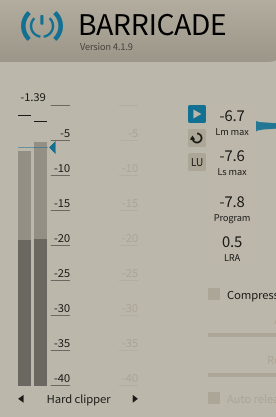Although dynamic sound of music is coming into trend again, the question how to make your music louder is still popular. Parallel compression is a well-known technique for achieving more subjective loudness (and along with that, natural sound dynamics). But, let’s say, you have completed this stage, and you’ll only have to realize final maximization on a master channel. Here, it happens that it’s not enough just to squeeze a mix with your favorite maximizer to a necessary volume.
In order to make songs louder with adding more color, double maximization will come useful for you. I use this technique in every mix. The point is that each limiter as well as a compressor has its own work character and therefore sound.
So…
At the first stage, I use a limiter that gives me a desired character of a mix at once. For some time it has been Barricade 4 from ToneBoosters that gives several behavioral models at option and different saturation modes as well. But you can definitely use that one which appropriate for you personally. So, with help of the first limiter, I reach the volume level with which the mix has a desired color and character. And still dynamic! With experience, you’ll learn to make out the point after which maximization makes a track flat and dead.

How to make a mix louder when this moment has come and it’s destructively to keep squeezing a track with the same settings?
The reply: if the received volume isn’t still sufficient, I finish squeezing the mix with the second limiter – with quite a more gentle attack and release settings for the most unnoticeable impact. The Gain Reduction values are very small at this stage. Around 0.5–1.5 dB.
And now another trick that I often use during mixing and mastering! For more color between the first and second limiters, I often put an equalizer and enhance Mids/High Mids with a narrow band (Q is equal to 3–5) two-three times. Try it yourself; this sequence gives absolutely different result as contrasted with standard practice when the maximizer is the very last link in a mastering chain.
The main thing, pay close attention to the absence of clipping at the equalization stage. The mix has already been maximized indeed! As a rule, I reduce the volume on the equalizer itself to stock up to process (minus 2 dB is sufficient). And I boost Gain of the next limiter to compensate the volume reduction during equalization.
RECOMMENDED ARTICLES:
- HOW TO REMIX A SONG
- HOW TO PERFORM ELECTRONIC MUSIC LIVE
- HOW TO MASTER MUSIC LOUDER AND WITH MORE COLOR
- HOW TO MIX ELECTRONIC DANCE MUSIC LOUD AND CLEAN
- WHAT IS MID SIDE PROCESSING
Any specific topic that you'd want to learn about?
Any other questions?
Feel free to ask - I'd love to help!
